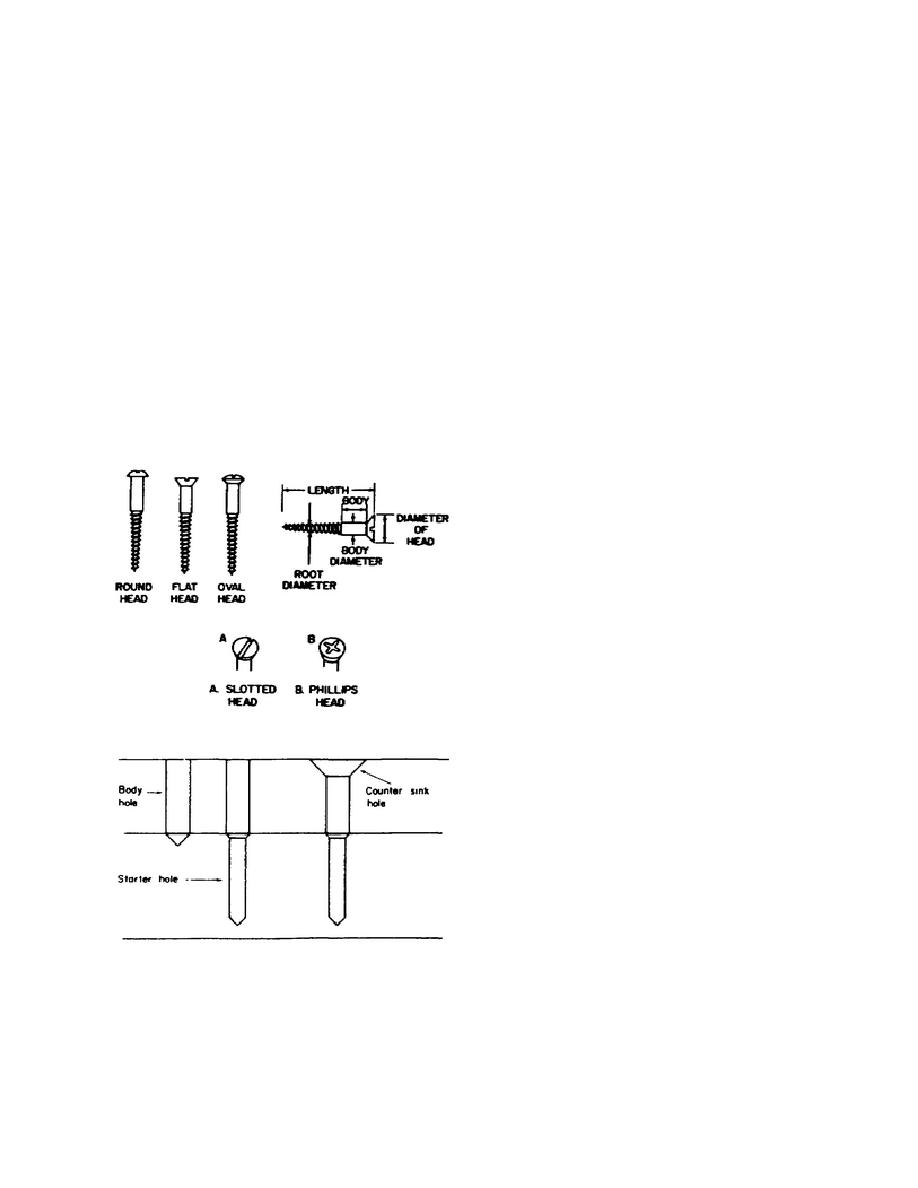
special-purpose screws are made of brass aluminum,
b. Screw sizes. Wood screws vary in
or stainless steel. Ordinary soft-steel screws may be
length from 1/4 inch to 6 inches. Screws up to 1 inch
bright finished or blued or they may be zinc,
in length increase by eighths of an inch screws from
cadmium, brass, or chrome plated. Wood screws
1 to 3 inches by quarter inches, and screws from 3 to
have gimlet points and are threaded for
5 inches by half inches. There are also 6-inch
approximately two-thirds of their length.
screws. Each length is made in a number of shaft
sizes indicated by an arbitrary number that represents
a. Types of wood screws. Wood screws
no particular measurement but indicates relative
are designated according to head styles as shown in
diameters. Tables 1-5 and 1-6 provide size, length,
figure 1-16.
The types commonly used in
gage, and applicable drill and bit sizes for screws.
construction are: slotted flathead, oval head, round
head, and Phillips head. To prepare wood for screws,
c. Lag screws. The proper name for lag
as shown in figure 1-17, bore a pilot or body hole the
screws in the nomenclature of the Army supply
diameter of the screw that is to be used through the
system is bolt, lag, wood-screw type. These screws
piece of wood that is to be fastened on. Then bore a
are sometimes required in frame construction. They
smaller starter or lead hold in the piece that is to be
are longer and much thicker bodied than common
fastened to, to avoid hard turning and the possibility
wood screws and have coarser threads which extend
of splitting the wood. If flatheaded screws are to be
from a cone or gimlet point slightly more than half
used the pilot or body hole should be countersunk.
the length of the screw. Both square- and hexagon-
headed lag screws are usually driven by a wrench.
Combined with expansion shields or anchors they are
used to attach timbers to existing masonry.
d. Expansion shields. Expansion shields,
or anchors as they are sometimes called, are inserted
in a predrilled hole. After the expansion shield is
inserted, the bolt or occasionally another type of
fastener such as a screw or even a nail is driven into
the shield, causing it to expand and become firmly
wedged in place (fig. 1-18).
1-22. BOLTS
a. General. Bolts are used in construction
when great strength is required or when the work
under construction must be frequently disassembled.
Figure 1-16. Types of wood screws.
Their use usually requires nuts for fastening and
washers to protect the surface of the material to be
fastened. Bolts are selected according to specific
requirements in terms of length, diameter, threads,
style of head, and type. Proper selection of head
style and type of bolt will result in good appearance
as well as good construction. The use of washers
underneath the nut or underneath both the nut and the
bolt head will avoid marring wood surfaces and
permit additional torque in tightening.
Figure 1-17. Method of preparing wood for screws.
1-23



 Previous Page
Previous Page
